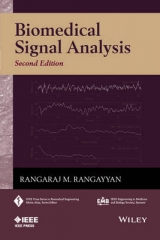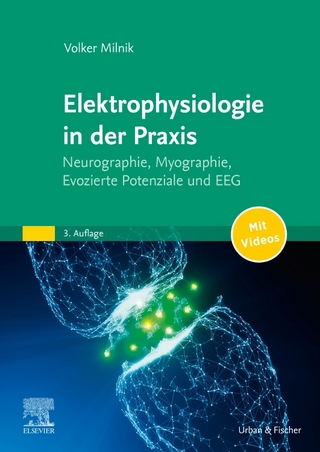
Biomedical Signal Analysis
John Wiley & Sons Inc (Verlag)
978-0-471-20811-2 (ISBN)
- Titel erscheint in neuer Auflage
- Artikel merken
Among the topics addressed are:* Concurrent, coupled, and correlated processes* Filtering for removal of artifacts* Event detection and characterization* Frequency-domain characterization* Modeling biomedical systems* Analysis of nonstationary signals* Pattern classification and diagnostic decisionThe chapters also present a number of laboratory exercises, study questions, and problems to facilitate preparation for class examinations and practical applications. Biomedical Signal Analysis provides a definitive resource for upper-level under-graduate and graduate engineering students, as well as for practicing engineers, computer scientists, information technologists, medical physicists, and data processing specialists. An authoritative assessment of the problems and applications of biomedical signals, rooted in practical case studies An Instructor Support FTP site is available from the Wiley editorial department: ftp://ftp.ieee.org/uploads/press/rangayyan
RANGARAJ M. RANGAYYAN, PhD, is Professor in the Department of Electrical and Computer Engineering at the University of Calgary in Calgary, Alberta, Canada, where he received the 1997 and 2001 Research Excellence Awards and the Killam Resident Fellowship in support of writing this book. He earned his doctorate in electrical engineering from the India Institute of Science in Bangalore, India. He is a Fellow of the IEEE, and was awarded the Third Millennium Medal of the IEEE in 2000.
Dedication. Preface. About the Author. Acknowledgments. Symbols and Abbreviations. 1 Introduction to Biomedical Signals. 1.1 The Nature of Biomedical Signals. 1.2 Examples of Biomedical Signals. 1.3 Objectives of Biomedical Signal Analysis. 1.4 Difficulties in Biomedical Signal Analysis. 1.5 Computer-aided Diagnosis. 1.6 Remarks. 1.7 Study Questions and Problems. 1.8 Laboratory Exercises and Projects. 2 Concurrent, Coupled, and Correlated Processes. 2.1 Problem Statement. 2.2 Illustration of the Problem with Case-studies. 2.3 Application: Segmentation of the PCG. 2.4 Remarks. 2.5 Study Questions and Problems. 2.6 Laboratory Exercises and Projects. 3 Filtering for Removal of Artifacts. 3.1 Problem Statement. 3.2 Illustration of the Problem with Case-studies. 3.3 Time-domain Filters. 3.4 Frequency-domain Filters. 3.5 Optimal Filtering: The Wiener Filter. 3.6 Adaptive Filters for Removal of Interference. 3.7 Selecting an Appropriate Filter. 3.8 Application: Removal of Artifacts in the ECG. 3.9 Application: Maternal - Fetal ECG. 3.10 Application: Muscle-contraction Interference. 3.11 Remarks. 3.12 Study Questions and Problems. 3.13 Laboratory Exercises and Projects. 4 Event Detection. 4.1 Problem Statement. 4.2 Illustration of the Problem with Case-studies. 4.3 Detection of Events and Waves. 4.4 Correlation Analysis of EEG channels. 4.5 Cross-spectral Techniques. 4.6 The Matched Filter. 4.7 Detection of the P Wave. 4.8 Homomorphic Filtering. 4.9 Application: ECG Rhythm Analysis. 4.10 Application: Identification of Heart Sounds. 4.11 Application: Detection of the Aortic Component of S2. 4.12 Remarks. 4.13 Study Questions and Problems. 4.14 Laboratory Exercises and Projects. 5 Waveshape and Waveform Complexity. 5.1 Problem Statement. 5.2 Illustration of the Problem with Case-studies. 5.3 Analysis of Event-related Potentials. 5.4 Morphological Analysis of ECG Waves. 5.5 Envelope Extraction and Analysis. 5.6 Analysis of Activity. 5.7 Application: Normal and Ectopic ECG Beats. 5.8 Application: Analysis of Exercise ECG. 5.9 Application: Analysis of Respiration. 5.10 Application: Correlates of Muscular Contraction. 5.11 Remarks. 5.12 Study Questions and Problems. 5.13 Laboratory Exercises and Projects. 6 Frequency-domain Characterization. 6.1 Problem Statement. 6.2 Illustration of the Problem with Case-studies. 6.3 The Fourier Spectrum. 6.4 Estimation of the Power Spectral Density Function. 6.5 Measures Derived from PSDs. 6.6 Application: Evaluation of Prosthetic Valves. 6.7 Remarks. 6.8 Study Questions and Problems. 6.9 Laboratory Exercises and Projects. 7 Modeling Biomedical Systems. 7.1 Problem Statement. 7.2 Illustration of the Problem. 7.3 Point Processes. 7.4 Parametric System Modeling. 7.5 Autoregressive or All-pole Modeling. 7.6 Pole-zero Modeling. 7.7 Electromechanical Models of Signal Generation. 7.8 Application: Heart-rate Variability. 7.9 Application: Spectral Modeling and Analysis of PCG Signals. 7.10 Application: Coronary Artery Disease. 7.11 Remarks. 7.12 Study Questions and Problems. 7.13 Laboratory Exercises and Projects. 8 Analysis of Nonstationary Signals. 8.1 Problem Statement. 8.2 Illustration of the Problem with Case-studies. 8.3 Time-variant Systems. 8.4 Fixed Segmentation. 8.5 Adaptive Segmentation. 8.6 Use of Adaptive Filters for Segmentation. 8.7 Application: Adaptive Segmentation of EEG Signals. 8.8 Application: Adaptive Segmentation of PCG Signals. 8.9 Application: Time-varying Analysis of Heart-rate Variability. 8.10 Remarks. 8.11 Study Questions and Problems. 8.12 Laboratory Exercises and Projects. 9 Pattern Classification and Diagnostic Decision. 9.1 Problem Statement. 9.2 Illustration of the Problem with Case-studies. 9.3 Pattern Classification. 9.4 Supervised Pattern Classification. 9.5 Unsupervised Pattern Classification. 9.6 Probabilistic Models and Statistical Decision. 9.7 Logistic Regression Analysis. 9.8 The Training and Test Steps. 9.9 Neural Networks. 9.10 Measures of Diagnostic Accuracy and Cost. 9.11 Reliability of Classifiers and Decisions. 9.12 Application: Normal versus Ectopic ECG Beats. 9.13 Application: Detection of Knee-joint Cartilage Pathology. 9.14 Remarks. 9.15 Study Questions and Problems. 9.16 Laboratory Exercises and Projects. References. Index.
| Erscheint lt. Verlag | 29.1.2002 |
|---|---|
| Reihe/Serie | IEEE Press Series in Biomedical Engineering | Wiley-Interscience |
| Zusatzinfo | Ill. |
| Verlagsort | New York |
| Sprache | englisch |
| Maße | 159 x 236 mm |
| Gewicht | 960 g |
| Themenwelt | Medizin / Pharmazie ► Medizinische Fachgebiete ► Biomedizin |
| Studium ► 2. Studienabschnitt (Klinik) ► Anamnese / Körperliche Untersuchung | |
| Naturwissenschaften ► Biologie ► Biochemie | |
| Naturwissenschaften ► Biologie ► Mikrobiologie / Immunologie | |
| Technik ► Medizintechnik | |
| ISBN-10 | 0-471-20811-6 / 0471208116 |
| ISBN-13 | 978-0-471-20811-2 / 9780471208112 |
| Zustand | Neuware |
| Informationen gemäß Produktsicherheitsverordnung (GPSR) | |
| Haben Sie eine Frage zum Produkt? |
aus dem Bereich



